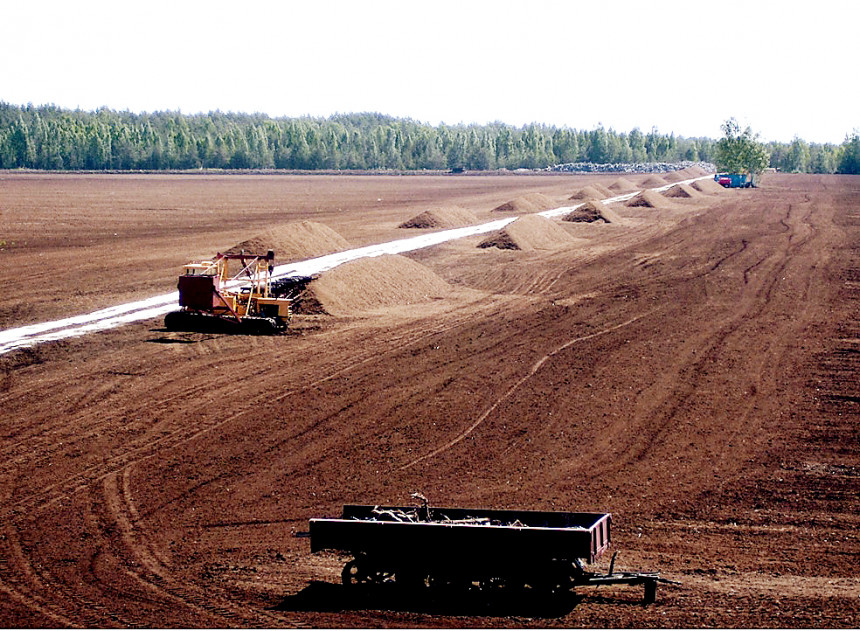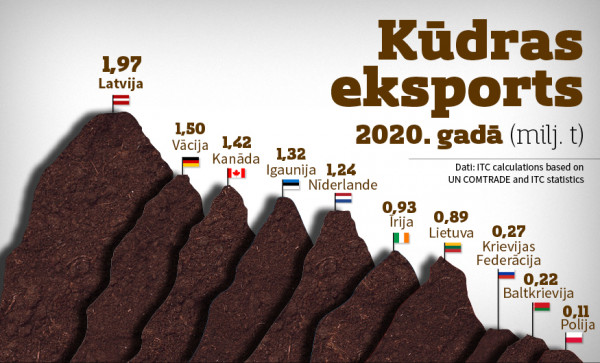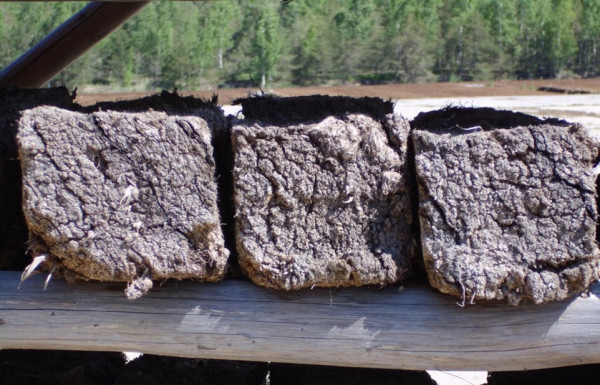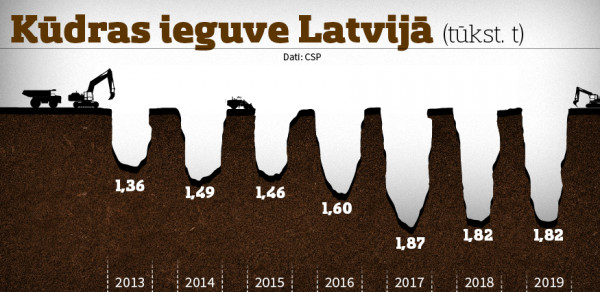For the third year in a row, Latvia is the largest exporter of peat in the world

According to the calculations of the International Trade Center, in 2020 Latvia was in the first place in the world in terms of the amount of exported peat. In 2020, Latvia exported 1.97 million tons of peat, Germany – 1.50 million tons, and Canada - 1.42 million tons of peat. In 2020, Estonia exported 1.32 million tons, the Netherlands 1.24 million tons and Ireland 0.93 million tons of peat.
In 2019, Latvia exported 1.71 million tons, Germany - 1.44 million tons, and Canada - 1.19 million tons of peat. In 2019, Estonia exported 1.08 million tons, Lithuania 0.87 million tons and Ireland 0.79 million tons of peat.
In 2018, Latvia exported 1.85 million tons of peat, Germany - 1.59 million tons, and Canada - 1.23 million tons. In 2018, Estonia exported 1.04 million tons, Lithuania 0.84 million tons and Ireland 0.77 million tons of peat.
Until 2018, Germany was the world's largest exporter of peat. The main importers of peat on the world market are Germany, Italy, China, the Netherlands, Belgium, Poland, Spain, the Republic of Korea, the US. In monetary terms, Latvia ranks second in the world in terms of peat exports, lagging behind Canada. In 2020, Latvia's income from peat exports was 237 million US dollars, in 2019 - 209 million dollars, but in 2018 - 211 million dollars.
Latvia's share of the global peat market in 2020 was 14.7%.
Latvia's peat exports versus extraction (2018-2019) were 98%, but this does not mean that Latvia exports almost all of its peat. Latvia is also a major importer of peat, mainly from Estonia, Lithuania, Belarus and Russia. The volume of Latvian peat imports in 2020 was 68 thousand tons.

However, the future of this Latvia's natural specialization industry is currently under threat. Latvian eurofundophages (European fund devourers) are interested in the European Green Deal Investment Plan that offers 450 million euros in exchange for the cessation of peat extraction. Stealing 450 million euros of European funds to kill a sector that provides 3,000 jobs in many regions of Latvia outside Riga - such acts must be seen as economic sabotage against the state. In addition, this economic sabotage is covered by loud slogans about nature, climate change and carbon dioxide.

Latvia's income from peat exports over the last three years was about 600 million euros, which is more than the Judas pennies that the European Green Deal Investment Plan proposes to give to Latvia for killing the economy of our rural areas and abandoning the sector in which Latvia is a stable world leader.
Today, peat extraction is not only an important export industry. The peat sector also has very significant strategic potential in the face of various global threats.
Peat is a local resource of Latvia, which has been the basis of Latvia's social stability and survival during critical situations. The importance of peat in Latvia's energy sector was of considerable importance in times when it was not possible to import energy resources. This was most evident during World War II. In 1940, the import possibilities of coal (at that time coal was the most important heat resource for Riga apartment buildings and industrial objects) were minimal, but firewood resources, if coal was replaced with them, would last enough for only two years. Therefore, during the reign of Ulmanis - in March 1940 - the people of Riga had the opportunity to get a small peat extraction field, where they could cut out and dry the peat to be used for heating in winter ("Brīvā Zeme", March 6, 1940). Also during the Nazi occupation, starting from 1942, the people of Riga had to take care of their own heating in winter. Each working family of Rigans was allocated a small peat field and non-working family members (at that time the working week was 72 hours, nowadays - 40 hours a week) had to cut and dry the peat during the summer to use it for winter heating (“Tēvija”, 26.05.1942).

During the USSR, there were not enough energy resources for the rapid development of the Latvian industry, so until Latvia was connected to the USSR natural gas system, Latvia had to use local energy resources. The only readily available resource was peat, so TEC-1 was created based on the combustion of Strenči peat stocks. The use of peat in Latvia reached its peak between 1960 and 1970, when an average of 1.8-2.1 million tons of peat was extracted in Latvia per year. During this time, peat accounted for a quarter of the energy resources consumed in Latvia. In 1960, peat accounted for 27% of Latvia's energy.
Burning peat has a very high level of pollution, a large amount of ash, so nowadays it is much more efficient to use natural gas or renewable resources in energy. Thus, in the 21st century, both in Latvia and elsewhere in the world, peat is practically not used as a fuel, but as a raw material for the production of agricultural fertilizers, black earth substrate, and other goods. Less than 2% of the peat obtained in Latvia is used as fuel, but all other peat obtained is a raw material for the production of mixtures and substrates for soil improvement.
However, in any case, peat extraction and export is a natural specialization of Latvia, which gives Latvia a stable export income, provides several thousand families with work and income in the regions of Latvia outside Riga.
*****
Be the first to read interesting news from Latvia and the world by joining our Telegram and Signal channels.
